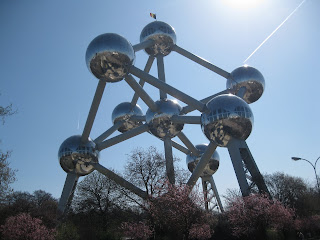Bit late getting this up, but oh well, you all are patient. Last time I wrote about the library and the area surrounding it in Wroclaw, Poland. Now I want to say a bit about the downtown and show a few pictures. The short version is that I really liked Wroclaw, and the next time you find yourself in Central or Eastern Europe you really should visit it. Wroclaw is a little tougher to get to, but if you want something that isn't crazy with tourists, but still very lovely and enjoyable (not to mention dirt cheap), then you can't go wrong with Wroclaw.

The main square is huge. It is a square like ones in the states where there is a big building in the middle and four blocks around it (meaning, it is not like Brussels, where the square is a big empty lot surrounded by buildings). Unlike American squares, though, it is only for pedestrians and bicycles. It's pretty hard to capture in a picture.
 This one shows maybe 1/2 of one side of the square. The buildings around the edge are very colorful and cheery. The next picture is the building in the middle. I wish I could tell you what it was, but I have no idea.
This one shows maybe 1/2 of one side of the square. The buildings around the edge are very colorful and cheery. The next picture is the building in the middle. I wish I could tell you what it was, but I have no idea. Also in the square was a shrine for the recently deceased Polish President and his wife. I was there a little less than a week after it happened. The mood around the shrine was very somber. I saw many people bringing candles and a handful crying.

This next picture captures what I oddly loved about Wroclaw, pristine beauty next to decaying Communist buildings. I tried to capture it in one shot as best I could. On the left is the main university building. On the right is what I guess an apartment building built during the Communist era when Poland was under Soviet rule. All over town it is quite evident that the Poles have made no effort whatsoever in keeping up the building constructed by the Reds. I didn't get many pictures of it, but scattered throughout the town are crumbling and ugly reminders of Wroclaw's bleak past.


A more cheerful reminder of that past, and a far better story is captured in the many gnome statues scattered throughout the city. I read online that these actually have a very interesting story. Apparently during Russian rule in the 1980s a group of students and professors started protesting the communists by making colorful, happy garden gnomes and placing them throughout the city. This seriously upset the Russians (who put out patrols to destroy all garden gnomes...seriously) but I think it is a brilliant and creative form of protest and truly captures what I love about the Poles. A few years ago the city commissioned some local artists to built bronze gnome statues to be placed throughout the city as a reminder of the revolution against the Russians. This picture was taken on the square. I read there are websites where all 150ish gnomes are marked on a map with gps coordinates. It is like that super weird hunting thing I did with Zack and Eve last summer (can't remember what it was called), except it is for victims of communist rule. Finally, the last picture I took facing out from the square, and I didn't even realize until I got home that one of the gnomes is hanging on the street light on the right.









